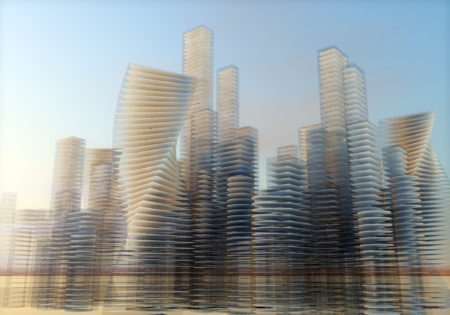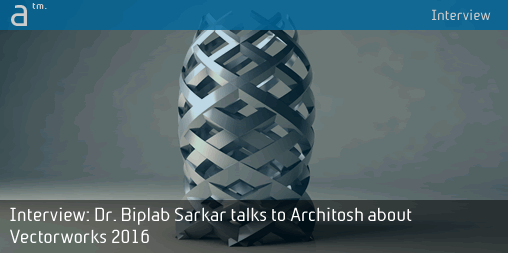From the moment Vectorworks, Inc., previewed what was coming up in this latest version back in the spring of this year, at their new Design Summit event, there has been some exciting buzz building for its actual release amongst its user base. The company did something totally new at this first ever event, it previewed features coming up in the next release. And it did it at an event where users had an unprecedented level of interaction with the developers of the software, enabling a rich interaction between software supplier and software user.
MORE: Vectorworks Design Summit: Wrap-Up and Details
The big news about Vectorworks 2016 is that it is arguably the biggest update to the Vectorworks product line in its history. Several developers running projects in the new research unit reached fruition status at the same time, including its new energy modeling technology, Energos, and its new Grasshopper-like algorithmic modeling and scripting environment, Marionette.
Still, the update for year 2016 contained some long-awaited answers to aspects of the program that affect architects the most, especially those working in large teams. Recently Dr. Biplab Sarkar, chief technology officer of Vectorworks, Inc., talked to me about the latest release, and I focused our discussion on two primary aspects: one particularly important for the BIM workflow, Project Sharing, and the other on Marionette, the first true cross-platform visual scripting algorithmic modeling and design environment. Below is our conversation.
Marionette
AFR (Anthony Frausto-Robledo): Vectorworks’ CEO Sean Flaherty said that he was realizing that Marionette is much more than a scripting environment. What was he referring to in the bigger sense?
BS (Dr. Biplab Sarkar): I think he was referring to that it doesn’t just drive the geometry, products like Grasshopper with Rhino–that’s what they do, drive the geometry–and create a final shape when they run the script. But in our case we can actually store the script as a plugin object at the end of the script. So Marionette is not really just a geometry driver but something richer that taps into our plugin architecture in Vectorworks software.
AFR: Are you seeing folks generating this output yet?
BS: Yes, what we are seeing is users starting to already do this. For example, creating Marionette scripts that handle things such as skylights or lights and actually storing these scripts as actual plugin objects that they can use later by changing the parameters.
AFR: So it is then possible that manufactures could use Marionette to create “scriptable” BIM model elements or objects where users can change parameters to derive model object options?

01 – Marionette driven explorations in urban architecture. Image: Vectorworks, Inc. All rights reserved.
BS: Yes, it could be. We are already seen some parallel processes from BIMobject®, for example. They have a different scripting environment that they support with manufacturers, using Rhino and their software tools.
We are thinking why not Marionette? Marionette can act very similarly to what those guys are doing with Rhino and the BIMobject environment.
AF: Right, and you guys also had a press release saying you were connecting Vectorworks into BIMobjects as well. Okay, so one other question I had regarding this is this: is it possible to setup an ODBC-based database¹ that can talk to Vectorworks and have it communicate with variables in Marionette scripts?
MORE: Nemetschek Vectorworks and BIMoject sign cooperation agreement
BS: It is possible. I was just talking to the development team about this but I don’t think we have tried it yet. There are Python calls that actually can access Vectorworks ODBC functionality. And of course, any record data function in Vectorworks can be connected to a database using ODBC connections. We could wrap the Python calls into a set of nodes so users could “wire up” an interface the way they want. We have not tried it yet but aim to.
AF: Let’s switch to the important point of how Marionette technology touches down in workflows in today’s users. Clearly this is technology that is bleeding edge in some respect and we all know how Grasshopper and Rhino are popular among architecture schools and cutting-edge design firms. But for all the other folks using Vectorworks today, what kind of training and support will you provide, what kind of aspirational materials will be offered to the installed base to give Marionette a try?
BS: We have posted a series of introductory training videos on our YouTube channel. On the community board we have actually created a Marionette area where users can share their nodes and scripts and get help and inspiration from one another. And that’s our mechanism for sharing to the outside world.
01 – this video is the first in a tutorial series on Marionette. Follow along to learn about this new technology for script-driven, parametric modeling on both Windows AND Mac!
We have a Marionette node for skylight design, for example, and a user took the example and changed the shape parameter simply from rectangular to circular and was amazed at the result that Marionette generated. All the other aspects of the script were maintained and this user was amazed at the simple power of this process. So this is the type of thing we want users to do, to access the examples and explore them and share their results with the community.
As the student community comes more online we will see even more of these being generated.
next page: Project Sharing & SubDivision Modeling




Reader Comments
https://t.co/WPJf8kqn7L — Architosh talks to Dr. Sarkar, chief technology officer at @Vectorworks about VW 2016!! https://t.co/nuJVAMK7YM
https://t.co/WPJf8kqn7L — Architosh talks to Dr. Sarkar, chief technology officer at @Vectorworks about VW 2016!! https://t.co/nuJVAMK7YM
https://t.co/WPJf8kqn7L — Architosh talks to Dr. Sarkar, chief technology officer at @Vectorworks about VW 2016!! https://t.co/nuJVAMK7YM
RT @architosh: https://t.co/WPJf8kqn7L — Architosh talks to Dr. Sarkar, chief technology officer at @Vectorworks about VW 2016!! https://t…
RT @architosh: https://t.co/WPJf8kqn7L — Architosh talks to Dr. Sarkar, chief technology officer at @Vectorworks about VW 2016!! https://t…
RT @architosh: https://t.co/WPJf8kqn7L — Architosh talks to Dr. Sarkar, chief technology officer at @Vectorworks about VW 2016!! https://t…
RT @architosh: https://t.co/WPJf8kqn7L — Architosh talks to Dr. Sarkar, chief technology officer at @Vectorworks about VW 2016!! https://t…
Comments are closed.